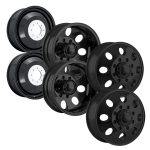Material Matters: Steel vs. Aluminum Oil Pans and Their Characteristics
The oil pan protects and stores vital engine oil. It sits low and endures stress from road conditions. Material choice plays a large role in performance. Steel and aluminum are the most common options today. Each material has unique strengths and weaknesses in use. The decision impacts durability maintenance and overall vehicle safety. Drivers often do not realize the difference between them. Yet the pan material directly affects lifespan and function. Strong construction supports the health of the engine system.
Strength of Steel Oil Pans
Steel oil pans are known for toughness and durability. They resist cracks and endure sudden road strikes. Steel bends under pressure instead of breaking apart. This makes steel more forgiving during heavy impacts. Rust remains the greatest weakness of steel construction. Exposure to moisture can eat through the metal. Rust holes then create leaks that grow worse daily. Proper coatings can slow this natural process of decay. Steel pans offer strength but need protection from corrosion. This is where choosing the Auto Repair in Colorado Spings, CO based service is essential here.
Benefits of Aluminum Oil Pans
Aluminum oil pans weigh less than steel pans overall. Lightweight design improves efficiency and performance in vehicles. Aluminum also dissipates heat more effectively than steel. Better heat control helps reduce engine operating temperatures. Cracks are a risk because aluminum is brittle. Unlike steel it breaks instead of bending under stress. Drivers often replace aluminum pans after sudden damage. Strong design still makes aluminum useful in modern engines. Aluminum pans remain popular for performance and cooling benefits.
Durability in Real Driving Conditions
Road hazards constantly threaten the safety of oil pans. Steel holds strong against rocks potholes and hard debris. Aluminum pans may fail faster under repeated road strikes. However aluminum handles constant heat cycles more effectively. Long term exposure to heat weakens steel faster than aluminum. Vehicle type often determines which pan works best. Heavy duty trucks rely on steel for protection and strength. Sports cars favor aluminum for cooling and weight reduction. Real conditions reveal both strengths and weaknesses clearly.
Maintenance Demands of Each Material
Steel pans require attention to prevent rust formation. Regular cleaning and protective coatings help extend lifespan. Owners must inspect steel for early corrosion signs often. Aluminum pans need checks for cracks and fractures instead. A small crack can lead to sudden major leaks. Mechanics use sealants or replacement to address such failures. Both materials demand different forms of care and service. Proper maintenance ensures the pan continues to perform safely. Maintenance habits often decide which material lasts longer.
Conclusion
The oil pan material directly impacts performance and safety. Steel provides toughness and durability against daily road strikes. Aluminum offers lighter weight and better heat dissipation under stress. Each material has unique risks such as rust or cracks. Drivers must care for the pan through regular maintenance always. The right material depends on purpose and vehicle type. Both materials keep engines safe when used properly every day. The oil pan may seem simple yet its material matters greatly. Strong design ensures long lasting engine health and protection.
















